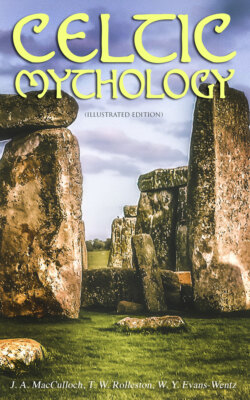Читать книгу CELTIC MYTHOLOGY (Illustrated Edition) - T. W. Rolleston - Страница 38
На сайте Литреса книга снята с продажи.
Traces of Magic in Megalithic Monuments
ОглавлениеThe imposing relics of their cult which the Megalithic People have left us are full of indications of their religion. Take, for instance, the remarkable tumulus of Mané-er-H'oeck, in Brittany. This monument was explored in 1864 by M. René Galles, who describes it as absolutely intact—the surface of the earth unbroken, and everything as the builders left it.9 At the entrance to the rectangular chamber was a sculptured slab, on which was graven a mysterious sign, perhaps the totem of a chief. Immediately on entering the chamber was found a beautiful pendant in green jasper about the size of an egg. On the floor in the centre of the chamber was a most singular arrangement, consisting of a large ring of jadite, slightly oval in shape, with a magnificent axe-head, also of jadite, its point resting on the ring. The axe was a well-known symbol of power or godhead, and is frequently found in rock-carvings of the Bronze Age, as well as in Egyptian hieroglyphs, Minoan carvings, &c. At a little distance from these there lay two large pendants of jasper, then an axe-head in white jade,10 then another jasper pendant. All these objects were ranged with evident intention en suite, forming a straight line which coincided exactly with one of the diagonals of the chamber, running from north-west to south-east. In one of the corners of the chamber were found 101 axe-heads in jade, jadite, and fibrolite. There were no traces of bones or cinders, no funerary urn; the structure was a cenotaph. “Are we not here,” asks Bertrand, “in presence of some ceremony relating to the practices of magic?”
